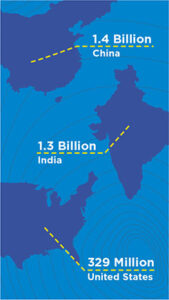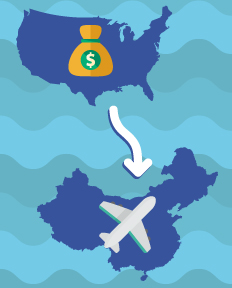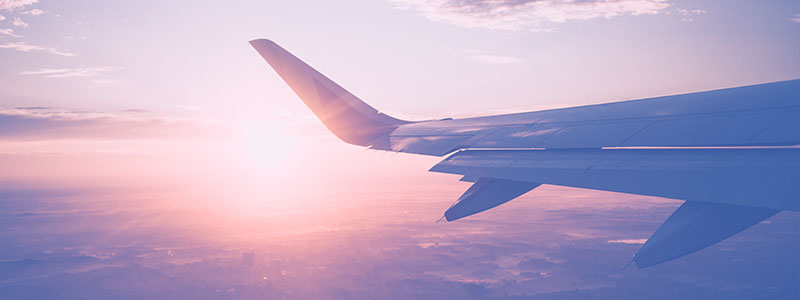A First Flight Success
On May 5, 2017, China’s first domestically built and designed airliner took off from Shanghai Pudong International airport. Constructed by the Commercial Aircraft Corporation of China (Comac), the airliner carried five crew members, nearly 168 passengers, and the hopes of a nation for an equally successful takeoff for its aviation industry. This flight certainly served notice to the world, as China joined the U.S., Russia, Brazil, the U.K., France, Germany and Canada as nations that have built and flown their own commercial airliners.
China’s Aviation Market Statistics
 China’s market size is quadruple that of the United States, with a population of 1.4 billion. Only India comes close in population, with 1.3 billion. The United States’ population is a distant third with 329 million.
China’s market size is quadruple that of the United States, with a population of 1.4 billion. Only India comes close in population, with 1.3 billion. The United States’ population is a distant third with 329 million.
According to The Economist, China’s passenger journeys on domestic flights rose from 184 million in 2007 to 550 million in 2017. China now has the world’s second-largest civil aviation industry in terms of air transport scale, and has set a goal of 11.4 percent year-over-year increases in passenger volume to 612 million passenger journeys in 2018, according to Shanghai Securities News.
By 2020, the Chinese government anticipates it will build 74 new airports as part of the country’s 13th Five-Year Plan, spanning 2016-2020. The plan also calls for a total of 5,000 general aviation aircraft and 7,000 pilots by 2020. All of this growth will result in greater connectivity between China’s lower-tier cities, and should also boost the nation’s on-time arrival rate from 67 percent in 2015 to 80 percent by 2020.
According to a CNN Money report, analysts predict that China will surpass the United States as the world’s largest commercial aviation market by 2030. The International Air Transport Association is much more aggressive in its predictions, believing that China will leapfrog the U.S. in the next five years.
Favorable Industrial Policies Portend a Chinese Aviation Boom
In January of 2018, the Civil Aviation Administration of China (CAAC) announced new policies allowing state and private firms to jointly or independently invest in China’s aviation industry. This opened the door to investment in the nation’s three largest airlines: Air China, China Eastern Airlines and China Southern airlines.

The new policies, including a market-oriented price setting notice, also encourage investment in China’s civil aviation industry to make it more globally competitive. Ticket prices for 306 air routes were adjusted by market to maximize the number of prospective passengers and ensure the Chinese aviation industry would take flight. These measures had an immediate impact, as the country’s civil aviation industry saw an average growth of 11.2 percent in flight hours, with annual total flight times rising from 6.19 million hours over the past five years to a projected 10.5 million hours.
America Is Seizing the Market Opportunity in China
 Revenues generated by Chinese industrial policies supported a buying spree of U.S. aircraft. In 2017, the Chinese government announced an order of 300 Boeing airplanes, valued at a total of $37 billion dollars. The state-owned China Aviation Supplies Holding Company also spent $23 billion dollars on 100 Airbus aircraft. Boeing estimates that Chinese airlines will purchase $1.1 trillion worth of aircraft in the next 20 years, estimated at a total of 7,000 planes. Boeing now has a B737 finishing factory and Airbus has an A320 final assembly plant in China.
Revenues generated by Chinese industrial policies supported a buying spree of U.S. aircraft. In 2017, the Chinese government announced an order of 300 Boeing airplanes, valued at a total of $37 billion dollars. The state-owned China Aviation Supplies Holding Company also spent $23 billion dollars on 100 Airbus aircraft. Boeing estimates that Chinese airlines will purchase $1.1 trillion worth of aircraft in the next 20 years, estimated at a total of 7,000 planes. Boeing now has a B737 finishing factory and Airbus has an A320 final assembly plant in China.
The United States is not content to benefit only from China’s investments in American aircraft, though it bargains hard for continued investments with its world-leading safety and durability records. In 2017, two transactions demonstrated the United States’ investment interest in China’s airlines. Delta Airlines paid $450 million dollars for a 3.55 percent stake in China Eastern Airlines, and American Airlines purchased a 2.76 percent share in China Southern Airlines for $200 million dollars. These investments pave the way for partnerships between the Chinese and American carriers.

Meanwhile, the United States is lobbying for an open-skies treaty with China, which would enable U.S. airlines to fly between any airports in the U.S. and China. Such a deal would make it possible for the major American airlines to partner with Chinese rivals to dominate flights in Asia-Pacific, as well as domestically in China. Rising trade tensions between the U.S. and China could delay or jeopardize these efforts, as could rival airlines in the Middle East, Europe and elsewhere in the Pacific.
In addition, Chinese President Xi Jinping has made it clear that he intends to reward market opportunities in the nation’s aviation market to countries and companies that transfer core technologies to China. This could enable American airlines to collaborate with the Chinese government and its aviation industry in developing the Chinese aviation infrastructure. For American aviation professionals including those with aerospace logistics expertise, this could offer a new world of career opportunities. China’s airlines will need help in all phases of the logistics process and program management, from acquisition through distribution, sustainment, and disposition. Recent graduates of specialized MBA aviation and aerospace programs would certainly benefit from these opportunities, along with a potential global talent supply shortage that could inflate wages.
Learn more about the SOSU online MBA program with an emphasis in Aviation Logistics.
Sources:
China Daily: China’s Aviation Sector to Fly Higher in 2018
The Economist: Chinese Aviation Takes Off
AirlineGeeks: China’s Burgeoning Aviation Industry
CNN Money: The Numbers Behind China’s Massive Aviation Market
CNN Money: China’s 1st Big Passenger Jet Completes Maiden Flight
U.S. Census Bureau: U.S. and World Population Clock
The State Council – The People’s Republic of China: 74 New Airports to Be Completed by 2020
